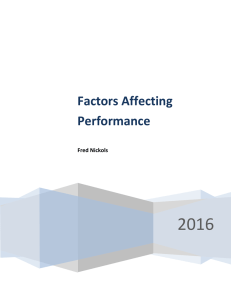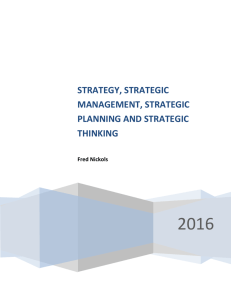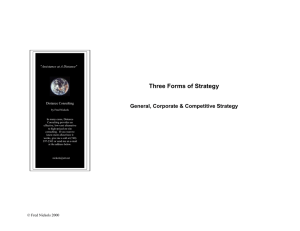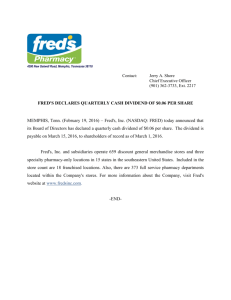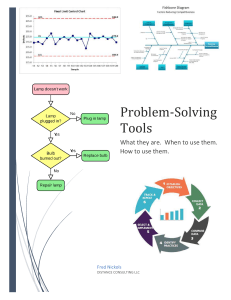Define Your Terms
advertisement
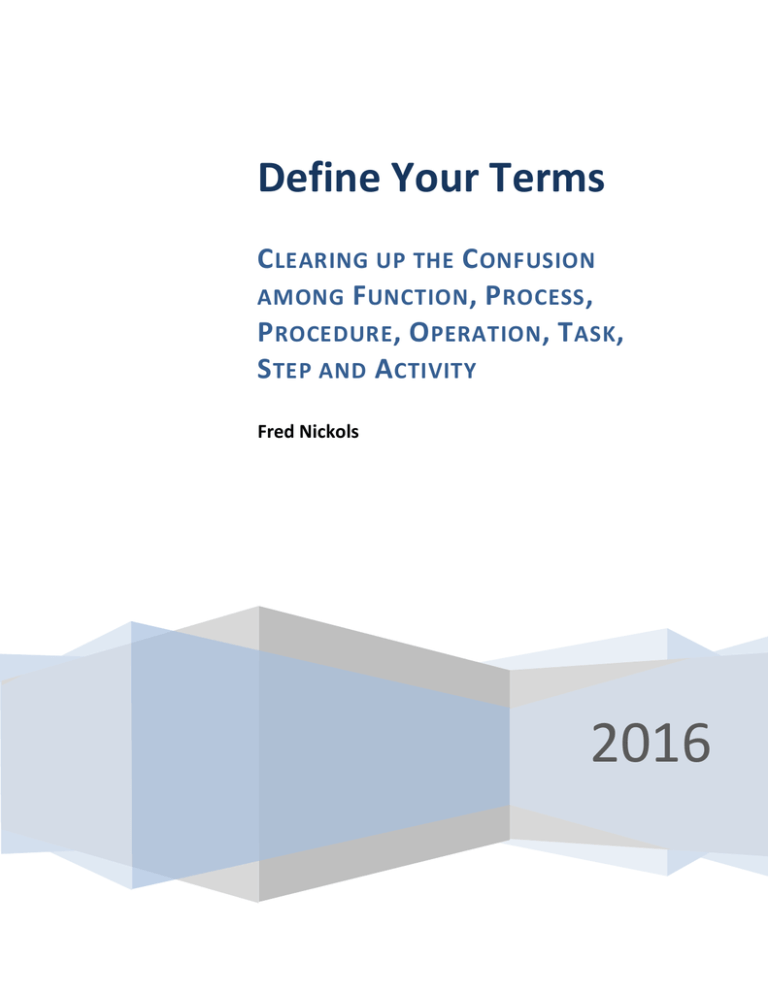
Define Your Terms C LEARING UP THE C ONFUSION AMONG F UNCTION , P ROCESS , P ROCEDURE , O PERATION , T ASK , S TEP AND A CTIVITY Fred Nickols 2016 DEFINE YOUR TERMS I NTRODUCTION This paper addresses and attempts to clarify the confusion that becomes evident whenever conversations in corporate settings make use of terms such as function, process, procedure, operation, task, step and activity. T HE N EED TO D EFINE O UR T ERMS First, it should be kept in mind that the terms listed above are frequently used interchangeably. All refer to action and it is not uncommon to hear one person refer to hiring as a function and to hear others refer to hiring as a process, an operation or simply as an activity. If shared meaning is essential to communication, and if terms have a wide range of meanings, then it follows that we must define our terms. We must give the terms above specific meanings for specific purposes. The alternative is endless babbling and squabbling based on different meanings and definitions. S OME D ICTIONARY D EFINITIONS Over the last couple of decades, the term “process” has taken on increased significance in the workplace, especially when coupled with other words such as business and reengineering. So we will tackle process first and function last and we will begin with dictionary definitions.1 A process is “a method of doing something, with all the steps involved.” A step is “any of a series of acts, processes, etc.” (Already the circularity appears.) An act is “a thing done.” An operation is “the act or an instance, process, or manner of functioning or operating.” An activity is “a specific action or function.” In turn, action is “the doing of something; a thing done.” Done means completed or ended, and that suggests a beginning as well as an ending; in other words, a boundary. One of the more common work activities with a clearly defined beginning and ending is the task. A task is “a piece of work to be done.” Task descriptions are often referred to as procedures. A procedure is the “act or method of proceeding in an action.” 1 The definitions given here are taken from Webster’s New World Dictionary. Pocket Books: New York, NY (2003). © Fred Nickols 2016 Page 1 DEFINE YOUR TERMS And what about function? Well, the dictionary says that a function is “a special duty required in work.” (There is, of course, more to it than that and we will come back to function a little later on.) The preceding foray through dictionary definitions highlights the problem with relying on or resorting to definitions: they are circular, overlapping and, taken singly, they don't help much. Moreover, as one wag said, “Definitions are found in the dictionary, meanings are found in people.” But, as a whole, the preceding definitions do shed some light on matters. S OME E MERGING C LARITY We are talking first of all about work, about purposeful, goal-oriented activity – activity with a result or outcome in mind. Or, as the dictionary puts it, work is “effort exerted to do or make something.” We are talking secondly about a series or sequence of activities, whether we choose to call them steps, tasks, operations, functions, or processes. Third, we are talking about different levels of detail. Finally, whether we choose to say that a process is made up of operations or that an operation consists of processes is less important than recognizing that we are using those terms to indicate relationships between and among levels of detail. Whenever we use terms like process, operation, step, function, or task, we are talking about related levels of sequenced activity intended to produce some specified result. Some of the relationships between work activities are horizontal, as is the case with a series or sequence of steps, tasks, functions, operations, or even processes. Some of the relationships are vertical, as when we say that steps make up a task, tasks make up functions, functions make up operations, and operations make up processes. Implied here is a hierarchy of detail, more detail at the bottom and less toward the top. One commonly used hierarchy of detail (from the top down) is job, task, and step, which is to say that a job consists of tasks, and that tasks consist of steps. Another is process, operation, and function. Owing to the magic of words, one can even construct a hierarchy that, from top to bottom, runs as follows: process, operation, function, job, task, and step. Another source of difficulty in all this is that the verb-object pairings used to construct action statements (e.g., open mail) are used to refer to specific, observable actions such as “press the enter key” and to broad constellations of activity such as “acquire new business.” In this way, we are able to construct ac- © Fred Nickols 2016 Page 2 DEFINE YOUR TERMS tion statements that refer to huge aggregations of more specific actions (e.g., operate a testing program). For the preceding reasons, it makes a big difference whether the analytical approach one takes is top-down (decompositional) or bottom-up (aggregational). Rolling up or aggregating concrete actions into increasingly high-level or abstract action statements is clearly broader-based and potentially more time consuming than a top-down approach. However, a top-down approach is necessarily an “armchair analysis” that runs the risk of never quite matching up with any one individual's perception of reality. R ELATIVE VS A BSOLUTE M EANING By now one of the main points of this paper should be painfully clear: the terms above don't have any absolute meaning, they have meaning only in relation to one another. Even then they have only the meaning that is assigned to them at the time and for the purpose at hand. Let us see, now, if we can turn this confusion to our advantage. Work activities are known variously as processes, operations, functions, procedures, tasks, and steps. In ordinary conversation, this isn't much of a problem. However, when work activities must be analyzed and documented, they are typically described at various levels of detail. In these circumstances, the meaning of the terms and how they are used becomes very important. Unfortunately, there are no universally accepted conventions for labeling the various levels of detail in such an analysis. Thus, we find some people saying that processes consist of a series of activities (any one of which might be referred to as a step), and other people saying that operations consist of functions and functions consist of processes. No one is right or wrong here; it's simply a matter of usage and convention. T HE F UNCTIONAL O RGANIZATION VS T HE P ROCESS V IEW And what of the confusion between function and process that prompted this discussion? Well, that isn’t really so much a matter of confusing the terms themselves as it is a matter of confusion between a couple of the derivative uses of those two terms, namely, the functional organization, and the process view. The term “function” is often used to refer to major areas of specialized activity within an organization (e.g., sales, marketing, manufacturing, finance, personnel, research, systems, operations, and so on). This is in keeping with the dic© Fred Nickols 2016 Page 3 DEFINE YOUR TERMS tionary view of function as “the kind of work proper to a person or institution.” When an entire company organizes itself around these specialized areas of activity, the organization is said to be a functional organization. T HE F UN CT I O N AL V I EW The functional view is a vertical view. The people who possess the specialized skills found in a functional area are typically organized into a system of hierarchically distributed authority (i.e., reporting relationships). Consequently, functional areas are sometimes referred to as “silos.” In contrast, the process view is a horizontal view; it is concerned with flows into, through, and out of the organization and, eventually, back into the organization. In a word, the process view is concerned with processes. In a functional or vertically focused organization, it is often the case that no one individual is accountable for processes that cross functional boundaries. They are instead typically responsible only for functions and functional areas and, at best, any processes confined to their functional area and perhaps those portions of cross-functional processes found within their functional areas. Consequently, end-to-end or corporate-wide process performance suffers. T HE P R O CESS V I EW Owing in large measure to the influence of systems thinking on movements such as Total Quality Management (TQM), Business Process Reengineering (BPR), and Activity-Based Costing (ABC), managers and executives are paying increasing attention to the process view as a way of improving the performance of their organizations. Here, “process” has several special meanings. A few of the more essential ones are presented below. Process - a series of activities intended to produce some output or outcome. These activities may be characterized as consisting of interactions between inputs to a system and processors in the system, the results of which constitute the outputs of the system. Production processes - processes intended to produce goods and services bound for customers. Production processes typically begin with customer needs, wants, and requirements, and terminate in goods or services delivered to the customer. Order fulfillment is a classic example. © Fred Nickols 2016 Page 4 DEFINE YOUR TERMS Maintenance processes - processes aimed at keeping the organization itself viable. Examples include training people in work process improvement methods and techniques, filing the necessary tax forms each year, investing in new equipment and technology, and importing new knowledge and skills in the form of new hires. Transaction processes - processes whereby an organization’s outputs are exchanged for inputs. One example is the buying-and-selling process. It is marked on one hand by the exchange of goods and services with customers in return for money and, on the other hand, by the exchange of money with suppliers in return for goods and services from them. Wages paid to employees in exchange for work performed is another example. Transformation processes - processes that convert one or more things into one or more other things (in systems terms, the conversion of inputs into outputs). Any number of examples comes to mind. For example, the process of recording one's responses converts a blank answer sheet into one that is filled out. Scanning is a process that converts marks on paper into electronic data. And scoring algorithms convert these marks into electronic data that are subsequently converted into a score. C ONCLUSION In the last analysis it makes very little difference whether you label a given activity statement as task, step, operation, function or process. What is important is to keep in mind that these labels refer to different levels of specificity of analysis with respect to work activities. Indeed, a tiered numbering system (e.g., 1.0, 1.1, 1.1.1and so on) avoids the confusion of labels and, better yet, maintains the connections between the levels of analysis. C ONTACT THE A UTHOR Fred Nickols can be reached via e-mail and other articles of his can be found on his web site. © Fred Nickols 2016 Page 5
